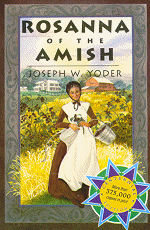You are here: PAGenWeb > Mifflin > Amish
Mifflin County Genealogy Project
Mifflin County Amish
By Cynthia Rosenberry
The Amish migrated to Pennsylvania after an invitation by William Penn who formulated the Great Law of 1682, assuring freedom from the bitter persecution they were experiencing in Switzerland, France and Germany.
According to The Amish of the Kishacoquillas Valley by J. Martin Stroup, after settlement of Berks and Lancaster Counties, Amish families, in groups, pushed on to the fertile Kishacoquillas Valley, also called Big Valley, around 1790 when Mifflin was being formed from Cumberland County. For a time, there was an Amish settlement in Lockport along the Juniata River during the early 1800's. Mifflin County was a popular way-station for many Amish families expanding westward.
The Amish system of beliefs found its origins in the Anabaptists. During the Reformation in Zurich, Switzerland in the 1520's, church leaders sought to restore the church based on New Testament principles but their ambitions were thwarted by the government. Those who kept to the original plan became branded by their detractors as Anabaptists due to their baptizing as adults those who had already been baptized as infants. This re-baptizing was criminal behavior according to an A. D. 529 Roman law and any member of this group caught was potentially put to death. Needless to say, the title "Anabaptists" was not welcome by the group due to the name's criminal association and also the fact that it was a title they'd had no say in. The group referred to themselves more accurately as Brethren. Leader Menno Simons formed a sect of the Brethren and thereafter, members of the reformed church became known widely as the Mennonites. The Amish are actually a split from this reformed church due to the influence of Jakob Ammann who objected that the Mennonites were not adhering strictly to certain practices such as the shunning of those who had been excommunicated from the group. This controversy brought out other differences in lifestyle. These new followers of Jakob Ammann's way became known as "Amish Mennonites" or just the "Amish".
The group of Amish who originally settled in Big Valley eventually split into several groups. The most interactive with the modern world of this group have split into three Mennonite groups. Those who still favor the old ways fall into five Amish groups. The more old-school groups are instantly recognizable on the road traveling by horse and buggy.
Nebraska Yoder & Zook Amish - most conservative, travel in two-seated buggies with white tops.
Byler Amish - also old-school but more progressive, travel in two-seated buggies with yellow tops.
Peachey or "Renno" Amish - the largest faction and most liberal of the horse and buggy Amish, travel in two-seated buggies with black tops.
Zook Church or "Speicher" Amish - use electricity, tractors and automobiles.
-source: The Amish of the Kishacoquillas Valley by J. Martin Stroup
Amish settlement remained in Big Valleyand exists there to this day, still evolving and growing although wary of change.
The Mifflin County Mennonite Historical Society
Zelda Yoder, PO Box 5603, Belleville, PA 17004
717-935-5574
More about Menno Simons (origin of term "Menno"nite) and
Jacob Ammann (origin of term "Am"ish) from PA Dutch Family Pages
PA Dutch Genealogy by Family Hart

|
Recommended Reading: Rosanna of the Amish The Biography of Rosanna McGonegal Yoder, her son, Joseph W. Yoder, a Mifflin County resident Rosanna of the Amish tells the unusual story of an Irish orphan, Rosanna McGonegal, who was reared by Elizabeth Yoder, an unmarried Amish woman. The author, Rosanna's youngest son, reveals how she was initiated into Amish ways and adopted their customs and practices. You will enjoy reading about Rosanna's first husking bee and singing. German preaching services and choosing ministers. Amish weddings and funerals. Wrestling matches between farm boys. Warm family and community relationships. |
Josie Baughman, Mifflin PAGenWeb County Coordinator
Copyright 2004-2018, USGenWeb Archives and Individual file contributors. All rights reserved.
Contributed by Cynthia Rosenberry, 2001.
This page was last updated 01/05/2018